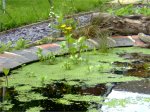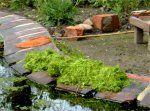I used to hate duckweed. I kept our old pond covered with a wire mesh to prevent accidents when our children were young. This meant that it was very difficult to get at the pond in order to do routine maintenance and the duckweed pretty much had its own way: it generally covered the whole pond,
 Duckweed on my pond
Duckweed on my pond
hiding most of the wildlife from view. It was while searching on the web for ways of combating it that I realised what an interesting plant it actually is.
I learned from the web (The Charms of Duckweed) about the tremendous possible economic benefits of duckweed. Duckweed can double its biomass in ten days (an incredible rate, but one which you will be able to believe if you have it on your pond) and there is a considerable amount of research going on into how this potential growth rate can be harnessed: one idea is to grow it as feed for pigs.
In order to grow so quickly, duckweed takes a lot of nutrients from the water. Since excessive nutrients are a common environmental problem in water bodies (including garden ponds), the potential beneficial effects of duckweed are obvious. Duckweed can also remove a lot of toxins from the water; again, its potential to do good is clear.
I actually used what I learned about duckweed to put it to good use when I created my new pond. As with any new pond, it takes a while for the water chemistry to settle down and my pond quickly suffered from an algal bloom. This was probably thanks to excessive nutrients in the new water and too much sun reaching into the water where the algae could grow. I needed to add some shade to the pond and I hit upon the idea of transferring duckweed from the old pond to do the job. As it grew, the duckweed also removed some of the excess nutrients from the new pond.
 Leave removed duckweed by the edge of the pond for a day or so
As long as it doesn't cover too much of the open water, it actually looks very attractive; its certainly does a fantastic job of hiding the ugly plastic baskets which contain my marginal plants. The wildlife, e.g. tadpoles, insect larvae and snails, are commonly found among the tangled mass of suspended roots: it adds a valuable extra structural dimension to the pond.
Leave removed duckweed by the edge of the pond for a day or so
As long as it doesn't cover too much of the open water, it actually looks very attractive; its certainly does a fantastic job of hiding the ugly plastic baskets which contain my marginal plants. The wildlife, e.g. tadpoles, insect larvae and snails, are commonly found among the tangled mass of suspended roots: it adds a valuable extra structural dimension to the pond.
Of course, because it grows so quickly, it needs to be cleared out regularly if you are to keep open water. By taking this biomass out, you (in partnership with the duckweed) are actually removing nutrients from the pond which is generally a good thing for the health of pond-life. As long as your pond is not covered by a mesh, it is fairly simple to clear excessive duckweed using a simple fishing net. You must check it for wildlife as you remove it though; particularly at his time of year when you are liable to net a lot of tadpoles too. Even after you have rescued any animals you find, you should still leave the removed duckweed at the edge of the pond for a day or so: this gives any animals you missed the chance to make their own way back.